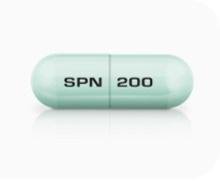Viloxazine Dosage
Medically reviewed by Drugs.com. Last updated on Sep 3, 2025.
Applies to the following strengths: 100 mg; 150 mg; 200 mg
Usual Adult Dose for:
Usual Pediatric Dose for:
Additional dosage information:
Usual Adult Dose for Attention Deficit Disorder
Initial dose: 200 mg
- May titrate in increments of 200 mg weekly based on response and tolerability
Comments:
- Pharmacologic treatment of Attention-Deficit Hyperactivity Disorder (ADHD) may be needed for extended periods. Periodically reevaluate the long-term use of this drug and adjust dosage as needed.
Use: For the treatment of ADHD in adults
Usual Pediatric Dose for Attention Deficit Disorder
6 to 11 years:
Initial dose: 100 mg orally once a day
- May titrate in increments of 100 mg per week based on response and tolerability
12 to 17 years:
Initial dose: 200 mg orally once a day
- After 1 week, may titrate to 400 mg once a day based on response and tolerability
Comments:
- Assess heart rate and blood pressure prior to initiating treatment.
- Screen patients for a personal or family history of suicide, bipolar disorder, and depression prior to initiating treatment.
- Pharmacologic treatment for ADHD may be needed for extended periods; periodically reevaluate and adjust dosage as needed.
Use: For the treatment of ADHD in pediatric patients 6 years or older.
Renal Dose Adjustments
Mild to moderate (estimated glomerular filtration rate [eGFR] 30 to 89 mL/min/1.73 m2): No adjustment recommended
Severe renal impairment (eGFR less than 30 mL/min/1.73 m2):
- Initial dose: 100 mg orally once a day
- May titrate in increments of 50 to 100 mg weekly based on response and tolerability
- Maximum dose: 200 mg/day
Liver Dose Adjustments
Data not available
Precautions
US FDA requires a medication guide to assure safe use. For additional information go to: www.fda.gov/drugs/drug-safety-and-availability/medication-guides
US BOXED WARNING: SUICIDAL THOUGHTS AND BEHAVIORS
- In clinical studies, higher rates of suicidal thoughts and behaviors were reported in pediatric patients with ADHD receiving this drug than in patients treated with placebo.
- Closely monitor patients for clinical worsening, and for emergence of suicidal thoughts and behaviors.
CONTRAINDICATIONS:
- Concomitant treatment with monoamine oxidase inhibitors (MAOI), or within 14 days following discontinuing an MAOI, because of an increased risk of hypertensive crisis
- Concomitant use of sensitive CYP450 1A2 substrates or CYP450 1A2 substrates with a narrow therapeutic range
Safety and efficacy have not been established in patients younger than 6 years old.
Consult WARNINGS section for additional precautions.
Dialysis
Data not available
Other Comments
Administration advice:
- Take orally once a day with or without food; do not cut, crush, or chew the capsules.
- May open capsule and sprinkle contents over a teaspoon of applesauce; consume in its entirety within 2 hours without chewing.
- Assess heart rate and blood pressure prior to initiating treatment.
- Screen patients for a personal or family history of suicide, bipolar disorder, and depression prior to initiating treatment.
Storage requirements:
- Store at 20C to 25C (68F to 77F), with excursions permitted between 15C and 30C (59F to 86F)
- If mixed with applesauce, use within 2 hours; do not store for future use.
General:
- There is a pregnancy registry that monitors pregnancy outcomes in women exposed to this drug during pregnancy; healthcare providers are encouraged to register patients by calling the National Pregnancy Registry for Psychiatric Medications at 1-866-961-2388 or visiting online at www.womensmentalhealth.org/preg.
Monitoring:
- Cardiovascular: Assess heart rate and blood pressure prior to therapy, following any dose increase, and periodically during therapy
- Metabolic: Monitor weight
- Psychiatric: Screen for personal or family history of suicide, bipolar disorder, and depression prior to therapy. Monitor for clinical worsening and emergence of suicidal thoughts and behaviors, especially during therapy initiation and with dose changes
Patient advice:
- Read the US FDA-approved patient labeling (Medication Guide).
- Family members and caregivers should be informed of the possibility of suicidal thoughts and behaviors and instructed to report behavioral changes or emergence of suicidal thoughts and behaviors promptly.
- Patients/caregivers should understand that there is a potential for somnolence and fatigue; they should understand how this drug affects them prior to engaging in activities requiring mental alertness.
Frequently asked questions
More about viloxazine
- Check interactions
- Compare alternatives
- Reviews (51)
- Side effects
- During pregnancy
- Drug class: adrenergic uptake inhibitors for ADHD
- Breastfeeding
- En español
Patient resources
Other brands
Professional resources
Other brands
Related treatment guides
See also:
Further information
Always consult your healthcare provider to ensure the information displayed on this page applies to your personal circumstances.


